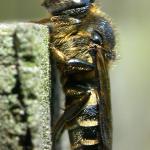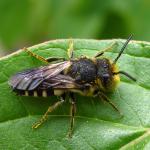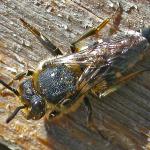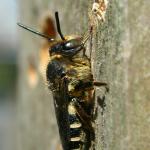Apis centuncularis acuminata CHRIST 1791; Coelioxys acuminata NYLANDER 1852; Coelioxys divergens FÖRSTER 1853; Coelioxys microdonta FÖRSTER 1853
There are currently no published keys to Coelioxys. George Else has a key in preparation. A photographic guide to the genus is available for download from the BWARS website. This species can be confused with C. elongata Lepeletier. It has a black gaster with pale bands and, in the female, elongated sixth tergite and fifth sternite.
Largely a southern species, appearing to favour the south-east of England but also the south coast of Wales. There are sporadic records from the south-west northwards to Cumberland and Yorkshire. There are no recent records for central England, central and north Wales or Scotland, but it is known from Ireland and the Channel Islands.
Occurring in central Europe, Italy, Lithuania and Finland.
This species is not regarded as being scarce or threatened.
Found in the same habitats as its hosts, though it appears to be found more frequently in dune systems at coastal sites than at inland locations.
It is on the wing from July to August.
This species is a cleptoparasite of Megachile maritima (Kirby) and M. centuncularis (Linnaeus). The females of all but one British species of Coelioxys have a pointed sixth tergite and fifth sternite which is apparently used to cut open the cell wall or cap of the host species. An egg is laid in this slit with at least one third protruding through into the cell or laid directly onto the host egg. There is currently no data to suggest which method C. inermis employs. Generally, Coelioxys larvae kill, and in some species eat, the host egg immediately on hatching. Pupation occurs within a cocoon spun within the host cell where the larva overwinters as a pre-pupa, prior to final pupation, presumably in spring of the following year.
Known to visit trefoils, clovers, scabious and sheep’s-bit.
No data available.
2012










